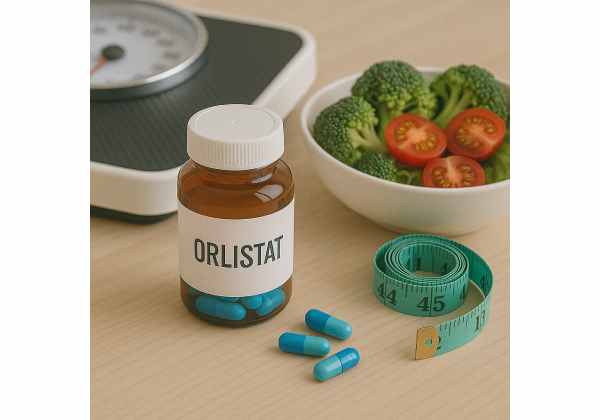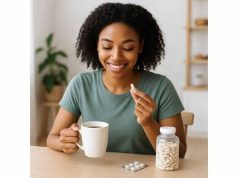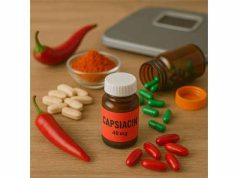Orlistat is one of the few weight-loss medicines that works in your gut rather than your brain. It blocks some of the fat you eat from being absorbed, so fewer calories make it into your body. That makes it different from appetite-targeting drugs—and it’s available both over the counter (Alli, 60 mg) and by prescription (Xenical, 120 mg). This guide explains exactly how orlistat works, what results to expect, and how to eat to avoid side effects. If you are comparing medications and supplements more broadly, see our overview of medical options for weight management. Use this article to set realistic goals, decide if orlistat fits your health profile, and learn a practical, low-fat eating pattern that supports steady, maintainable weight loss.
Table of Contents
- What is orlistat and does it work?
- How orlistat works for weight loss
- Who should use it and how to start
- Dose, timing and diet on orlistat
- Common mistakes and side-effect fixes
- Safety, interactions and who should avoid
- Results timeline and when to stop
- Frequently Asked Questions
What is orlistat and does it work?
Orlistat is a lipase inhibitor: it reduces the digestion and absorption of dietary fat. In practical terms, that means a portion of the fat grams you eat pass through your digestive tract unabsorbed, lowering your daily calorie intake without changing what your brain perceives as hunger or fullness. Unlike medicines that act on appetite pathways, orlistat works locally in the intestine and has very low systemic absorption.
There are two strengths:
- Alli (over-the-counter): 60 mg per dose.
- Xenical (prescription): 120 mg per dose.
Both are taken with meals that contain fat, up to three times per day. People often ask if the higher prescription dose “doubles” the effect. The relationship is not linear, but the 120 mg strength blocks a greater fraction of dietary fat and has been studied in longer, more intensive clinical trials.
Does it work? In one-year programs that pair orlistat with nutrition and activity coaching, average weight loss is modest but meaningful. Many participants lose 3–5% of starting weight beyond what lifestyle changes alone produce, and a higher share of people reach clinically significant milestones (≥5% and ≥10% loss). Because the medicine reduces fat absorption consistently, small daily calorie deficits accumulate: a few hundred calories per day over months translates to several kilograms lost.
The benefits extend beyond the scale. Orlistat often lowers LDL cholesterol and can improve blood pressure and blood-sugar control in people with insulin resistance. Its effect is strongest when you follow a reduced-calorie, lower-fat pattern and keep dosing consistent. If you are still learning the fundamentals—calorie balance, protein targets, and sustainable activity—start with our concise guide to safe weight-loss fundamentals, then layer orlistat on top for an extra push.
Who tends to do well with orlistat?
- Planners: people willing to track fat grams per meal and follow a predictable eating pattern.
- Those with high-fat diets today: the drug blocks more calories when baseline fat intake is higher (though you still need to reduce overall calories).
- People who prefer non-stimulant options: because orlistat doesn’t act on the central nervous system, it avoids stimulant-like effects.
Who tends to struggle?
- Fans of very high-fat diets (e.g., ketogenic plans). The required fat restriction conflicts with the diet’s core design.
- People with irritable bowels may find the gastrointestinal side effects harder to manage, especially early on.
Bottom line: orlistat works best as a disciplined add-on to an already sound nutrition plan. Set expectations around steady, modest loss rather than rapid drops.
How orlistat works for weight loss
When you eat fat, enzymes called pancreatic and gastric lipases break triglycerides into free fatty acids your intestine can absorb. Orlistat binds to those enzymes and inactivates them, so roughly a quarter of meal fat remains undigested and exits in the stool. Because the effect is local and tied to each meal, timing matters: you take it with the meal or within an hour after eating.
A few practical implications follow from that mechanism:
- Meal-by-meal effect. No meal, no dose. A fat-free meal, skip the dose. The drug doesn’t accumulate.
- Not a carb blocker. Calories from carbs and protein still count.
- Vitamin impact. Blocking fat absorption also reduces absorption of fat-soluble vitamins A, D, E, and K. Plan to take a multivitamin at bedtime (or at least 2 hours after your last dose).
- Dose consistency. Because the effect is proportional to fat in the meal, keeping fat intake evenly distributed across the day reduces surprises.
People often compare orlistat with appetite-pathway medicines like GLP-1 medications. Mechanistically, they are opposites: GLP-1s reduce appetite and slow gastric emptying; orlistat reduces calorie absorption from fat. That means orlistat pairs well with behavioral strategies (protein-forward meals, high-fiber foods, fewer liquid calories) and can be an option for those who prefer to avoid drugs that act on the brain.
Why early side effects happen. If you eat a high-fat meal while taking orlistat, the undigested fat stays in the gut, leading to oily stools, urgency, and gas with discharge. Think of this as a feedback loop: the medicine quickly shows you when a meal exceeds your fat budget.
Metabolic effects: Because it reduces fat absorption, orlistat lowers calorie intake without necessarily dropping food volume. Over time, this can ease the psychological strain of dieting for some people, especially when meals are built around lean protein, high-fiber produce, whole grains, and modest amounts of healthy fats.
Key takeaway: Orlistat is a tool that amplifies a lower-fat, calorie-reduced pattern. Use it to make a good plan more effective—not to “cancel out” fast food.
Who should use it and how to start
Who qualifies: Adults with overweight or obesity are candidates, particularly if they prefer a non-stimulant medication and can follow a lower-fat eating pattern. The prescription dose is often reserved for people with BMI ≥30, or ≥27 with weight-related conditions (such as dyslipidemia, prediabetes, or hypertension). The over-the-counter dose can be used more broadly, but it should still fit within a supervised weight-management plan.
Who benefits most:
- You respond well to structure—meal planning and fat-gram targets.
- You already started lifestyle changes but want another 3–5% loss over the next 6–12 months.
- You have lipid issues (elevated LDL cholesterol) where a fat-absorption blocker may help.
Who may not fit:
- You follow high-fat regimens (keto, very-low-carb with heavy fats).
- You have gastrointestinal conditions that could worsen with increased fat in the stool.
- You take medicines that interact (see safety section).
How to start, step by step
- Pick the strength. Discuss prescription 120 mg vs OTC 60 mg with your clinician. Consider cost, tolerability, and your medical history.
- Set your daily fat budget. A workable target is ≤30% of calories from fat, distributed evenly. On a 1,500-kcal plan, that’s about 50 g fat/day, or 15–18 g per main meal with a few grams left for snacks.
- Plan three main meals. Orlistat is designed for up to three doses/day with meals that contain fat. Skip if a meal is fat-free or you skip the meal.
- Add a bedtime multivitamin. Choose one with vitamins A, D, E, and K; take it 2+ hours after your last orlistat dose.
- Prepare for week 1–2. Side effects are dose-dependent on fat intake. Keep meals lean, carry spare clothing or liners at first if you’re worried, and learn your triggers.
- Track and review at 12 weeks. If you haven’t lost ~5% of starting weight at the full dose with good adherence, discuss whether to continue, adjust, or switch therapies. A broader overview of options is in our guide to who qualifies for weight-loss medicines.
Realistic goals: Expect steady, modest loss (for example, 0.3–0.7 kg per week once you’re in a calorie deficit), with the first noticeable change in waist measurement and LDL within 1–2 months. Orlistat complements—not replaces—habit change.
Dose, timing and diet on orlistat
Dosing basics
- Alli (OTC): 60 mg with each fat-containing main meal, up to 3 times/day.
- Xenical (Rx): 120 mg with each fat-containing main meal, up to 3 times/day.
- Timing: Take during the meal or within 1 hour after.
- Skip the dose if you skip a meal or the meal is very low-fat.
- Snacks: Do not “add doses” for snacks.
Your fat budget
Aim for ≤30% of daily calories from fat, evenly spread. Practical targets:
- 1,500 kcal/day: ~50 g fat/day → 15–18 g per main meal
- 1,800 kcal/day: ~60 g fat/day → 18–20 g per main meal
Use food labels and a tracker to stay within range. The steadier your per-meal fat, the fewer surprises you’ll have.
What to eat
- Protein anchors (20–35 g/meal): skinless poultry, fish, lean beef/pork, tofu/tempeh, egg whites, low-fat dairy, Greek yogurt (0–2%).
- High-fiber carbs: vegetables, beans/lentils (rinse well), oats, quinoa, barley, whole-grain breads/pastas.
- Fats (small amounts): 1–2 tsp olive or canola oil, 1–2 tbsp light dressing, avocado slices, small handful of nuts (count the grams).
- Beverages: water, unsweetened tea/coffee, low-fat milk or fortified alternatives.
Cooking tips
- Bake, grill, air-fry, poach, or steam; avoid deep frying.
- Use nonstick pans; measure oils, don’t “eyeball.”
- Choose lean cuts; trim visible fat; remove poultry skin.
- Build flavor with acids (lemon, vinegar), herbs, spices, garlic, chiles.
Sample day (≈1,500–1,600 kcal; ~50 g fat)
- Breakfast (dose): egg-white veggie scramble, whole-grain toast (1 tsp soft spread), berries, coffee with splash of 1% milk. (~12–15 g fat)
- Lunch (dose): grilled chicken salad, mixed greens, chickpeas, tomatoes, cucumbers, 2 tbsp light vinaigrette; whole-grain roll. (~15–18 g fat)
- Snack: apple and 170 g 0% Greek yogurt with cinnamon. (~2–3 g fat)
- Dinner (dose): baked salmon (120 g) or marinated tofu, quinoa, roasted broccoli, lemon. Use 2 tsp oil for cooking. (~18–20 g fat)
- Bedtime: multivitamin (ADEK).
Managing vitamins and minerals
- Take a multivitamin with A, D, E, and K at bedtime (or ≥2 hours after your last dose).
- If you eat little dairy or sun exposure is limited, discuss vitamin D testing.
- Consider calcium and B12 from food or supplements if intake is low.
If you want extra appetite control with fewer calories, soluble fiber can help meals feel fuller. See our comparison of fiber supplements if you’re considering glucomannan or psyllium alongside orlistat.
Common mistakes and side-effect fixes
1) Eating high-fat meals and hoping the pill “covers it.”
Orlistat is not a license for fast food. The more fat a meal contains, the more unabsorbed fat enters your colon—leading to oily stools, urgency, and gas. Solution: keep per-meal fat within your target and split higher-fat foods across meals.
2) Skipping breakfast, then eating a heavy dinner.
Large single-meal fat loads cause more symptoms. Aim for 3 balanced meals, each with similar fat grams. If you skip a meal or eat a very low-fat meal, skip the dose.
3) Forgetting the bedtime multivitamin.
Fat-soluble vitamin absorption drops with orlistat. Take a daily multivitamin at bedtime or ≥2 hours after your last dose to protect A, D, E, and K status.
4) Taking orlistat with snacks.
Dosing beyond 3 times/day increases side-effect risk without extra benefit. Keep doses to main meals only.
5) Not reading labels.
“Low-fat” on the front can hide high fat per serving on the back. Read grams per serving and servings per package. Our quick guide on how to read supplement labels can sharpen your skills.
6) Ignoring hydration and fiber.
Adequate fluid and soluble fiber can normalize bowel habits. Add oats, beans, barley, chia, or psyllium gradually to avoid bloating.
7) Assuming all fats are equal.
Keep overall fat modest, but choose unsaturated fats when you use them (olive/canola oil, nuts, seeds) and limit saturated fats (fatty cuts, butter, heavy cheese).
8) Stopping too soon—or staying too long.
Evaluate at 12 weeks on the full dose. If you haven’t lost ~5% of starting weight with good adherence, discuss whether to stop, switch, or combine therapies.
Troubleshooting quick guide
- Oily spotting/urgency: Lower fat grams at the next similar meal; carry liners early on; identify trigger foods.
- Constipation: Increase fluids and soluble fiber; consider psyllium once daily.
- Loose stools: Check for hidden fats; reduce fried foods, full-fat dairy, and large restaurant portions.
- Plateau: Reassess calorie balance (protein targets, portions, liquid calories) and activity.
Safety, interactions and who should avoid
Common side effects (often dose-related to meal fat): oily/loose stools, gas with discharge, urgency, more frequent bowel movements, abdominal cramping. These usually improve after 1–2 weeks when you keep per-meal fat consistent.
Less common but important:
- Fat-soluble vitamin deficiency (A, D, E, K) if multivitamins are skipped.
- Oxalate kidney stones (rare): unabsorbed fat can increase intestinal oxalate absorption. Hydration and moderate dietary oxalate (spinach, beets, nuts) help if you’re prone.
- Liver injury (rare): stop and seek care for yellow skin/eyes, dark urine, severe fatigue, or right-upper-quadrant pain.
Do not use orlistat if you have:
- Chronic malabsorption syndrome or cholestasis
- Known hypersensitivity to orlistat or any component
- Pregnancy
Use caution and talk with your clinician if you:
- Have kidney disease (especially history of stones)
- Have gallbladder problems or a history of pancreatitis
- Have IBS or chronic diarrhea
Drug interactions to know
- Levothyroxine: take at least 4 hours apart; monitor TSH for dose adequacy.
- Warfarin: vitamin K absorption may decrease; monitor INR closely.
- Cyclosporine: levels can drop; many clinicians avoid co-use or require careful level monitoring with separation in dosing.
- Fat-soluble supplements (A, D, E, K) and some anticonvulsants: absorption may be reduced; individualize and monitor.
- Oral contraceptives: orlistat does not directly reduce effectiveness; however, severe diarrhea can affect pill absorption—use backup if that occurs.
Not tolerating orlistat, or not meeting weight-loss targets? Discuss alternatives such as metformin for weight (in selected cases) or other agents that might suit your medical profile and preferences.
Key safety habits
- Take a daily ADEK-containing multivitamin at bedtime.
- Keep fat grams per meal predictable.
- Recheck lipids, A1C, and weight at intervals set by your clinician.
- Stop the medicine and seek care for jaundice, severe abdominal pain, or signs of dehydration.
Results timeline and when to stop
Weeks 1–2: You’re learning your fat budget. Side effects (if any) reflect meals that overshoot it. Expect small scale changes and better waist measurements if sodium intake drops.
Weeks 3–8: With consistent dosing and a calorie deficit, most people see steady loss—often 0.3–0.7 kg/week. Hunger is usually manageable because meal volume remains good (protein + fiber).
Months 3–6: If adherence stays high, total loss often reaches 5–10% of starting weight. You may notice improvements in LDL cholesterol, blood pressure, energy for everyday activity, and sleep quality.
Months 6–12: Weight tends to stabilize unless you adjust calories or activity. Orlistat can be continued for maintenance if you tolerate it and labs remain stable.
When to stop or switch
- No meaningful response: If you haven’t lost about 5% of starting weight after 12 weeks on the full dose with good adherence, reassess your plan. Stopping is reasonable rather than continuing indefinitely without benefit.
- Side effects remain intrusive despite excellent meal planning.
- Medical reasons: new contraindications, problematic lab changes, or interactions that can’t be managed.
How to measure success
- Track percent of body weight lost, waist circumference, and health markers (LDL, A1C, blood pressure)—not just the absolute number on the scale.
- Use a weekly average weight (daily weights can be noisy).
- Pair with strength training 2–3 times/week to preserve lean mass and metabolic rate.
If you later transition to a different therapy, bring your best practices with you (protein targets, fiber, label reading, consistent meal timing). Those habits carry most of the long-term return on effort.
Frequently Asked Questions
How much fat per meal is safe on orlistat?
Aim for 15–20 g of fat per main meal on a 1,500–1,800-kcal plan, keeping daily fat ≤30% of calories. Distribute fat evenly across breakfast, lunch, and dinner. Skipping a dose when a meal is very low-fat reduces side effects and doesn’t reduce overall results.
Can I take orlistat with a high-protein, low-carb diet?
Yes—if the diet is also low in fat. High-protein is compatible; high-fat is not. Choose lean proteins, low-fat dairy, beans, vegetables, and whole grains. Keep oils, full-fat cheese, and fried foods modest to avoid gastrointestinal side effects.
Do I need to take vitamins with orlistat?
Yes. Because orlistat reduces absorption of vitamins A, D, E, and K, take a daily multivitamin at bedtime or at least 2 hours after your last dose. This timing prevents the drug from blocking vitamin absorption and protects long-term nutritional status.
What happens if I eat a very high-fat meal while taking orlistat?
Expect oily stools, urgency, and gas with discharge within 24 hours. These effects are the result of undigested fat reaching the colon. Return to your fat-gram targets at the next meal to prevent repeat episodes. Carry liners early on if you’re concerned.
Is orlistat safe for long-term use?
For many adults, yes—with monitoring. Continue regular check-ins on weight, lipids, A1C, and vitamin status if indicated. Stop and seek care for jaundice, dark urine, or severe abdominal pain. Reassess benefit at 12 weeks and at least annually thereafter.
Does orlistat affect birth control pills?
Orlistat doesn’t directly reduce pill effectiveness. However, severe diarrhea can impair pill absorption. If you experience significant diarrhea, use backup contraception for that cycle and discuss persistent symptoms with your clinician.
Can I drink alcohol while using orlistat?
Moderate alcohol (1 drink/day for women, 2 for men) does not interact directly, but alcohol adds calories and can loosen food restraint. If alcohol leads to high-fat meals or overeating, your results and tolerability will suffer.
References
- Efficacy of Orlistat in type 2 diabetes – a systematic review and meta analysis – PubMed (2025, Systematic Review)
- Pharmacotherapy for adults with overweight and obesity: a systematic review and network meta-analysis of randomised controlled trials – PubMed (2024, Systematic Review/Network Meta-analysis)
- AGA Clinical Practice Guideline on Pharmacological Interventions for Adults With Obesity – PubMed (2022, Guideline)
- Prescribing orlistat, liraglutide and semaglutide | Tools and resources | Overweight and obesity management | Guidance | NICE (2025, Guideline)
- DailyMed – XENICAL- orlistat capsule (2022, Prescribing Information)
Disclaimer
This article is for general education only and does not replace personalized medical advice, diagnosis, or treatment. Always consult a qualified health professional before starting, stopping, or combining medications, supplements, or major diet changes—especially if you have chronic conditions, take prescription drugs, are pregnant, or are planning pregnancy.
If you found this helpful, consider sharing it with a friend or family member who’s exploring weight-loss options. To keep up with future guides, follow us on the social network you already use—Facebook, X, Instagram, or LinkedIn.

















